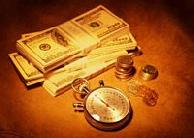
 |
|
| Financial Terms | |
| Derivitive |
|
Information about financial, finance, business, accounting, payroll, inventory, investment, money, inventory control, stock trading, financial advisor, tax advisor, credit.
Main Page: credit, financial advisor, financial, payroll, investment, business, stock trading, inventory, |
Definition of Derivitive
DerivitiveAn instrument with a value that is derived from the value of the
Related Terms:NPV (net present value of cash flows)Same as PV, but usually includes a subtraction for an initial cash outlay. PV (present value of cash flows)the value in today’s dollars of cash flows that occur in different time periods. Adjusted present value (APV)The net present value analysis of an asset if financed solely by equity Alternative mortgage instrumentsVariations of mortgage instruments such as adjustable-rate and variablerate Asset-backed securityA security that is collateralized by loans, leases, receivables, or installment contracts Bond valueWith respect to convertible bonds, the value the security would have if it were not convertible Book valueA company's book value is its total assets minus intangible assets and liabilities, such as debt. A  Book value per shareThe ratio of stockholder equity to the average number of common shares. Book value Carrying valueBook value. Cash-surrender valueAn amount the insurance company will pay if the policyholder ends a whole life Conversion valueAlso called parity value, the value of a convertible security if it is converted immediately. Convertible securityA security that can be converted into common stock at the option of the security holder, Debt instrumentAn asset requiring fixed dollar payments, such as a government or corporate bond. Deliverable instrumentThe asset in a forward contract that will be delivered in the future at an agree-upon price. Derivative instrumentsContracts such as options and futures whose price is derived from the price of the Derivative securityA financial security, such as an option, or future, whose value is derived in part from the  Exchangeable Securitysecurity that grants the security holder the right to exchange the security for the Exercise valueThe amount of advantage over a current market transaction provided by an in-the-money Expected valueThe weighted average of a probability distribution. Expected value of perfect informationThe expected value if the future uncertain outcomes could be known Extraordinary positive valueA positive net present value. Face valueSee: Par value. Firm's net value of debtTotal firm value minus total firm debt. Fixed-dollar securityA nonnegotiable debt security that can be redeemed at some fixed price or according to Fixed-income instrumentsAssets that pay a fixed-dollar amount, such as bonds and preferred stock. Future valueThe amount of cash at a specified date in the future that is equivalent in value to a specified Host securityThe security to which a warrant is attached.  Hybrid securityA convertible security whose optioned common stock is trading in a middle range, causing InstrumentsFinancial securities, such as money market instruments or capital market insturments. Intrinsic value of an optionThe amount by which an option is in-the-money. An option which is not in-themoney Intrinsic value of a firmThe present value of a firm's expected future net cash flows discounted by the Investment valueRelated:straight value. Limited-liability instrumentA security, such as a call option, in which the owner can only lose his initial Liquidation valueNet amount that could be realized by selling the assets of a firm after paying the debt. Loan valueThe amount a policyholder may borrow against a whole life insurance policy at the interest rate Limited-liability instrumentA security, such as a call option, in which the owner can only lose his initial investment. Market value1) The price at which a security is trading and could presumably be purchased or sold. Market value ratiosRatios that relate the market price of the firm's common stock to selected financial Market value-weighted indexAn index of a group of securities computed by calculating a weighted average Maturity valueRelated: par value. Monthly income preferred security (MIP)Preferred stock issued by a subsidiary located in a tax haven. Mortgage pass-through securityAlso called a passthrough, a security created when one or more mortgage Net adjusted present valueThe adjusted present value minus the initial cost of an investment. Net asset value (NAV)The value of a fund's investments. For a mutual fund, the net asset value per share Net book valueThe current book value of an asset or liability; that is, its original book value net of any Net present value (NPV)The present value of the expected future cash flows minus the cost. Net present value of growth opportunitiesA model valuing a firm in which net present value of new Net present value of future investmentsThe present value of the total sum of NPVs expected to result from Net present value ruleAn investment is worth making if it has a positive NPV. Projects with negative NPVs Net salvage valueThe after-tax net cash flow for terminating the project. Original face valueThe principal amount of the mortgage as of its issue date. Par valueAlso called the maturity value or face value, the amount that the issuer agrees to pay at the maturity date. Parity valueRelated:conversion value Present valueThe amount of cash today that is equivalent in value to a payment, or to a stream of payments, Present value factorFactor used to calculate an estimate of the present value of an amount to be received in Present value of growth opportunities (NPV)Net present value of investments the firm is expected to make Price value of a basis point (PVBP)Also called the dollar value of a basis point, a measure of the change in Primitive securityAn instrument such as a stock or bond for which payments depend only on the financial Relative valueThe attractiveness measured in terms of risk, liquidity, and return of one instrument relative to Replacement valueCurrent cost of replacing the firm's assets. Residual valueUsually refers to the value of a lessor's property at the time the lease expires. Salvage valueScrap value of plant and equipment. SecurityPiece of paper that proves ownership of stocks, bonds and other investments. Security characteristic lineA plot of the excess return on a security over the risk-free rate as a function of Security deposit (initial)Synonymous with the term margin. A cash amount of funds that must be deposited Security deposit (maintenance)Related: Maintenance margin security market line (SML). A description of Security market lineLine representing the relationship between expected return and market risk. Security selection decisionChoosing the particular securities to include in a portfolio. Standardized valueAlso called the normal deviate, the distance of one data point from the mean, divided by Straight valueAlso called investment value, the value of a convertible security without the con-version option. Terminal valueThe value of a bond at maturity, typically its par value, or the value of an asset (or an entire Time value of an optionThe portion of an option's premium that is based on the amount of time remaining Time value of moneyThe idea that a dollar today is worth more than a dollar in the future, because the dollar Underlying assetThe asset that an option gives the option holder the right to buy or to sell. Underlying securityOptions: the security subject to being purchased or sold upon exercise of an option Utility valueThe welfare a given investor assigns to an investment with a particular return and risk. Value-added taxMethod of indirect taxation whereby a tax is levied at each stage of production on the value Value-at-Risk model (VAR)Procedure for estimating the probability of portfolio losses exceeding some Value additivity principalPrevails when the value of a whole group of assets exactly equals the sum of the Value dateIn the market for Eurodollar deposits and foreign exchange, value date refers to the delivery date Value datingRefers to when value or credit is given for funds transferred between banks. Value managerA manager who seeks to buy stocks that are at a discount to their "fair value" and sell them at Variable price securityA security, such as stocks or bonds, that sells at a fluctuating, market-determined price. BOOK VALUEAn asset’s cost basis minus accumulated depreciation. BOOK VALUE OF COMMON STOCKThe theoretical amount per share that each stockholder would receive if a company’s assets were sold on the balance sheet’s date. Book value equals: CAPITAL IN EXCESS OF PAR VALUEWhat a company collected when it sold stock for more than the par value per share. PAR VALUEAn arbitrary value that a company may assign to its stock. Par value has no relationship to what the stock is selling for on the open market. SALVAGE VALUEThe amount management estimates a piece of equipment will be worth at the end of its useful life, either as a trade-in or if it were sold for scrap. Cash value added (CVA)A method of investment appraisal that calculates the ratio of the net present value of an Economic Value Added (EVA)Operating profit, adjusted to remove distortions caused by certain accounting rules, less a charge Net present value (NPV)A discounted cash flow technique used for investment appraisal that calculates the present value of future cash flows and deducts the initial capital investment. Shareholder valueIncreasing the value of the business to its shareholders, achieved through a combination of Value-based managementA variety of approaches that emphasize increasing shareholder value as the primary goal of every business. No par value stockStock issued by the company that does not have an arbitrary value (par value) assigned to it. Par valueAn arbitrary value assigned by the company to each share of stock; it is used in the accounting for the sale of stock and in some jurisdictions for calculating taxes. Stated value stockStock issued by the company that does not have a par value, but does have a stated value. For accounting purposes, stated value is functionally equivalent to par value. book value and book value per shareGenerally speaking, these terms net present value (NPV)Equals the present value (PV) of a capital investment present value (PV)This amount is calculated by discounting the future Book ValueThe value of an asset as carried on the balance sheet of a Related to : financial, finance, business, accounting, payroll, inventory, investment, money, inventory control, stock trading, financial advisor, tax advisor, credit. |